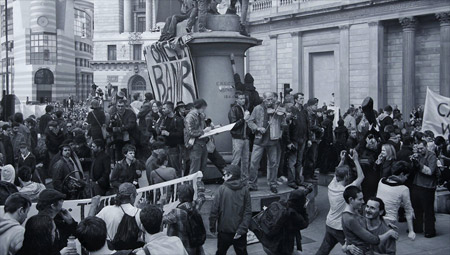
| HOME |
| NERVE |
| REVIEWS |
| ARCHIVE |
| EVENTS |
| LINKS |
| ABOUT US |
| CONTRIBUTORS |
| BACK ISSUES |
| CONTACT US |
 John
Moores Painting Prize 2010
John
Moores Painting Prize 2010
Walker Art Gallery
18th September 2010 – 3rd January 2011
Reviewed by Sandra Gibson
You know when a painting is good: the interest or provocation is powerful enough to generate excitement. Something in the head and something in the belly. Although there were some interesting issues raised by this exhibition, I didn’t find very much to excite me.
And I did go twice.
Of the winning paintings only Daniel Sturgis’s Still Squallings (2009) had ingredient X and I was glad to revisit it. It does what it says: combining the horizontally still with the diagonally kinetic. I was impressed by the elegance of the decorative technique and composition and the balance of the static areas of hot colour with the orderly dance of black, grey and white squares. Why is such a painting so satisfying? Is it to do with the potency of the space at the right hand side of the painting which takes something away from its flatness? Or is it the dots of pale blue that counterbalance the angularity of the other shapes? It’s hard to know and it doesn’t matter. What matters is that I am still thinking about it and visualising it. I love it.
The overall winner, Spectrum Jesus (2009) by Keith Coventry interested me on two counts. Firstly because of something the artist said about it: “The reflective glass slows down the speed at which you can consume the image.” The word consume had me considering the way in which gallery visitors do indeed gawp and peer and evaluate and judge and decide if a work of art repays the effort taken to view it. Or the way in which art buffs collect experiences like tourists do. I also considered the sense of consuming an experience until it is assimilated into the mind set of the viewer. So far so cerebral. What of the experience of actually looking at Spectrum Jesus? It required effort. The artist had arranged that by the choice of deep colour glazed by reflective glass so that the iconic image was interfered with by extraneous light and the reflected image of the viewer. The ancient and still face of Christ peers back but you have to make the effort to see beyond the self and the diverting world you are inhabiting.
The second point of interest concerns the fact that this painting is one of a series executed in different colours. I wondered what it would be like to experience this, and I wondered how the artist had decided which one to submit, and whether the choice of a different colour would have cost him the prize.
I’m still thinking about it; by provoking me into considering the act of perception the artist has led me to look at the position of religious experience in a secular world. But he didn’t hit me in the gut.
I’m afraid I feel rather dismissive of the other winning entries. Nicholas Middleton’s Protest 1st April 2009 (2010, above) is technically praiseworthy. Its pageant-like depiction of a contemporary event is Brueghel-like in its attention to individual narratives within the main narrative. But if you want pictorial narrative look at the epic examples from previous centuries available in the same gallery. Philip Diggle’s For Your Pleasure (2009) is indeed pleasurable but the celebration of the pigment and texture and stuffness of paint has been done better and bigger. Nick Fox’s Metatopia (2009) interests because of its masterly use of glazes and ink on a circular panel, and its skilful creation of a landscape which has an oriental sense of spaciousness and restraint. It’s a mind space as well - imbued with a sense of melancholy yearning.
Then there are the Chinese winners. The John Moores Painting Prize has been opened to artists resident in China, on the same principles which apply in the UK. There is not a great deal to provoke or surprise. Zhang Zhenxue’s Peach Blossom (2010) combines the delicacy of a restrained palette with decorative flatness and a feeling of space. We’ve seen it before. Zhang Wei’s The Emperor Mountain (2010) is monumentally impressive and texturally reminiscent of the work of Anselm Keifer. Zon Tao’s Excrement Factory (2008) is technically well realised but it’s not a very fresh metaphor - though an interesting counterpoint to the other entries from Shanghai. Li Weizhon’s Where are we from? Where will we go? (2009) combines the universal with the contemporary. Its refinement and the balance between space and drawing are exquisite but the work reminds me of one of those Michelin starred dishes that are aesthetically appealing but nothing to do with satisfying real hunger. Han Feng’s Big Plane (2008) has a similar sparse elegance and is almost abstract in its division of the space. I found this the most satisfying of the Chinese exhibits.
This is a prestigious competition with three thousand works submitted and forty-five works accepted. I thought it would have been more than interesting.